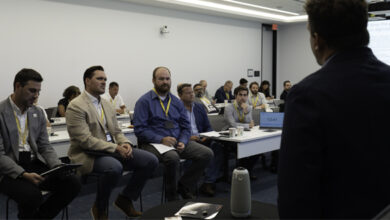New process automation platform aims to pave path to drilling consistency, efficiency
By Ben Facker, Ryan Hanford, Chris Mullin, Vinesh Rambally, National Oilwell Varco

Demand for automated technology continues to grow throughout the industry despite the decline in oil price and reduction in capital spend across the board. Driven by sub-optimal industry conditions, operators are searching for faster, safer and more consistent wells, leaving drilling contractors the difficult task of optimizing their rigs. Contractors are faced with several challenges to compete in the current market: how to maintain operations with a shrinking workforce, how to enhance their existing fleet, and how to safely manage a multitude of third parties vying to optimize the control of their assets.
Despite difficult market conditions and a challenging environment, National Oilwell Varco (NOV) is working to provide a solution with the National Oilwell Varco Operating System (NOVOS) process automation platform.
NOVOS is a software platform that pairs with NOV integrated systems to automate the drilling process. The platform orchestrates the rig equipment to execute slips to slips drilling much as the driller does today. Using a well program that describes the desired well profile, the process automation platform breaks down the planned drilling process into smaller, scheduled operations with identified start and end points. NOVOS continues to perform the planned operations unless human input is required to handle a boundary condition or well control situation.
Consistency through automation
The lack of experienced personnel is a challenge that all companies in the industry must face. Sole reliance on worker skills and experience leaves companies vulnerable, which is painfully obvious to most after witnessing the boom and bust cycles of the industry. In a boom, companies invest heavily in hiring and training personnel to catch up with available work. In a bust, companies must shed costs, and a large portion of the investments in personnel are lost during workforce reductions.
The NOVOS process automation platform addresses the variance in experience and skills by directly handling some of the repetitive tasks that drillers typically perform, all while keeping them engaged as the process manager. One such repetitive task is tagging bottom and restarting the Autodriller. Although this task is performed hundreds of times during a single well, drillers will perform the operation differently depending on their experience level and their level of concentration. NOVOS can perform typical drilling activities with efficiency and consistency that humans simply cannot replicate over time.
Hardware and equipment capabilities
Applying automation to a drilling rig has been an ongoing challenge for the past decade due to the time and complexity of building a new rig to meet equipment requirements. Instead of requiring an overhaul of the control system, NOVOS extends the capabilities of existing NOV control systems. This allows for an installation that can be completed within a couple of days and is scalable across a fleet of existing NOV rigs. Quick and easy installation provides the industry with immediate access to automated rig controls.
A rig does not require full autonomous mechanical equipment to implement process automation. NOVOS is designed to adapt to various equipment capabilities by allowing human input into the automation layer. For example, when a rig has manual slips, NOVOS provides the driller with the ability to input when the slips are enabled or disabled. Keeping the human driller in the loop replaces missing layers in the automation process.
Ease of installation and the ability to adapt to varying equipment capabilities provides a solution to previous integration challenges. As a result, NOVOS can be quickly scaled across rig fleets, providing all parties the ability to efficiently apply drilling optimization.
Third-party control
Currently, third-party integration requires extensive knowledge of rig equipment and collaboration between rig owners and service contractors. To counter this challenge, NOVOS was designed with third-party control in mind. Operators, contractors or service companies can now apply optimization through applications while maintaining proven safety and precision through NOV control systems. Applications have a wide variety of functions within the system and can be written to control almost any part of the drilling process that NOVOS handles. Applications can be layered, prioritized and partitioned to provide flexibility of control and monitoring in a way the industry has never seen.
Applications can be tailored for specific events in the drilling process. For example, a directional drilling company may want to integrate an application that improves ROP through automatic control of parameters in order to optimize performance. Another example is an operator wanting to apply an application that automatically schedules a hole-cleaning or other process. Through the use of applications, significant increases in drilling optimization, efficiency and safety can be achieved. NOVOS can also utilize applications to monitor the well construction process and detect events or departures from what is expected. Through process automation, adjustments are made accordingly, all while keeping the human in the loop.
The rig contractor owns the rig assets and, therefore, the automation platform. Access can be provided to approved external users for uploading applications and well programs into the platform. Access to interact with the platform is granted on a per-user basis and requires the use of secure protocols and certificate authentication.
Future of NOVOS
Automation in the oilfield is not a new concept, and many of the challenges are well known. NOVOS addresses these well-known pain points.
NOVOS is undergoing extensive testing at NOV’s all-inclusive test rig in Navasota, Texas. The process automation platform will be deployed on multiple land and offshore rigs through the next year. Trials with select operator, contractor and service providers for automated process control and application implementation are under way.
Implementation of a process automation platform is a big step toward the future of automation in the industry. As sensors and equipment for mechanization of the drill floor become available in the coming years, process automation will be the cornerstone to enable hands-free well manufacturing.
This article is based on a presentation at the 2015 IADC Advanced Rig Technology Conference & Exhibition, 13-14 October in Amsterdam.




